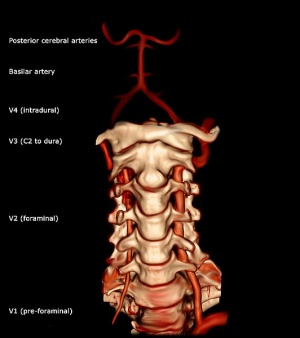Vertebral Artery
Description[edit | edit source]
The vertebral artery is a major artery in the neck[1]. It branches from the subclavian artery, where it arises from the posterosuperior portion of the subclavian artery.
Path[edit | edit source]
It ascends though the foramina of the transverse processes of the cervical vertebrae, usually starting at C6 but entering as high as C4[2]. It winds behind the superior articular process of the atlas. It enters the cranium through the foramen magnum where it unites with the opposite vertebral artery to form the basilar artery (at the lower border of the pons)[3].
Divisions[edit | edit source]
The vertebral artery can be divided into four divisions:
- The first division runs posterocranial between the longus colli and the scalenus anterior.[3] The first division is also called the ‘pre-foraminal division’.[1]
- The second division runs cranial through the foramina in the cervical transverse processes of the cervical vertebrae C2.[3] The second division is also called the foraminal division[1].
- The third division is defined as the part that rises from C2. It rises from the latter foramen on the medial side of the rectus capitis lateralis, and curves behind the superior articular process of the atlas. Then, it lies in the
- groove on the upper surface of the posterior arch of the atlas, and enters the vertebral canal by passing beneath the posterior atlantoöccipital membrane[3].
- The fourth part pierces the dura mater and inclines medial to the front of the medulla oblongata.[3]







